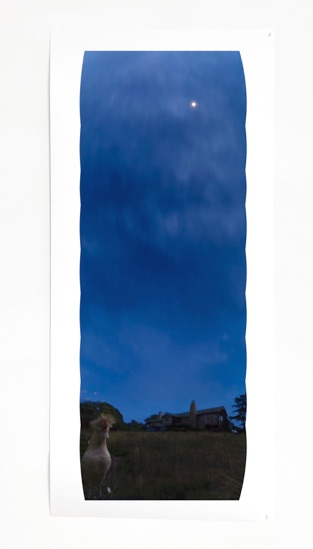(Re)collecting An American’s Dream (READ) explores conflicting issues of preservation and development in the mediums of stills, video, mixed media and social practice (2006 - 2008). The subject is the historic 13 acre estate Gissa-Bu (circa 1930) where Sandrow followed the cockeral Shinnecock (March 30 2006) across the road days after the lands were clear cut of trees. Two exhibits, at PS1/MOMA and Southampton Historical Museum (at The Rogers Mansion formerly Samuel L. Parrish home at the time he owned the 13 acres) were mounted to engage the community in the ultimately successful preservation effort.
“This lot (thirteen acres estate Gissa Bu) and the forest and field vegetation it contains is a snapshot in time depicting Shinnecock Hills as it used to be. The plant communities on the subject parcel represent a natural resource of the Town of Southampton that is fast disappearing. Once it is gone, it is unlikely that it will be seen again. As such, all efforts must be made to preserve as much of the existing vegetation as possible. One of the most striking features of this parcel is the tall, majestic pine trees found on the northern and western areas of the property. These tall pine trees are not only visibly pleasing, but also are an active roosting area of the Blue Heron, one of the larger and more visibly locally significant bird species. The subject parcel was inspected on October 10, 2001 at approximately 11:00 AM. During this brief visit, numerous individuals were observed on the western portion of the parcel in the southern portions of proposed lot 1 and the northern portions of proposed lot 2. This habitat is arguably the most critical roosting are for Blue Herons around Shinnecock Bay, and perhaps the Town. Loss of habitat is the number one cause of species disappearance. Because of this species recreational and aesthetic importance, it is imperative that this roosting area be preserved.”
Harry Ludlow, Chairman Town Conservation Board, excerpt March 2004 letter to Southampton Town Planning Board
A permit for demolition of Gissa Bu in the developer’s hand to make way for construction of “The Manors at South Hampton”. In response a collaboration began with Sandrow and neighboring Shinnecock Indian Nation, one of the oldest continuously self-governing Native American tribes in the country. Together advocating for acquisition of the estate by the Town of Southampton Community Preservation Fund to ensure the historic home and lands, believed to be a a site of ancestral burials on hills along the shores of Shinnecock Bay, remain undisturbed. Sandrow’s photographs, research and documentation used to gain the recognition “Seven to Save” by the Preservation League of New York State (2007).
As these thirteen acres, as well as the surrounding hills, had remained in their natural state for centuries as Shinnecock Nation Territories. Until they were forced to relinquish their claim of the lands to the town of Southampton who offered it for development after 1859 to a group of developers eventually led by Samuel L. Parrish. In many ways, Southampton's development history, and many towns across America, is encapsulated in the story of this land, which Parrish acquired (personally in 1892) and sold to World War I fighter pilot, Aviation pioneer and icon Lamotte T. Cohu (1929).
“Because his wife, the former Didi H. Muus, is Norwegian, Mr. Cohu built for her at Southampton a summer home like a Norwegian mountain house. A Norwegian architect (Thjorbjorn Bassoe) designed it, Norwegian craftsmen were imported (from Norway on a ship with the building materials) to make the wood carvings. Mrs. Cohu named the house Gissa Bu (mystery house). Time Magazine, excerpted from article “Cohu for Coburn” March 28, 1932


